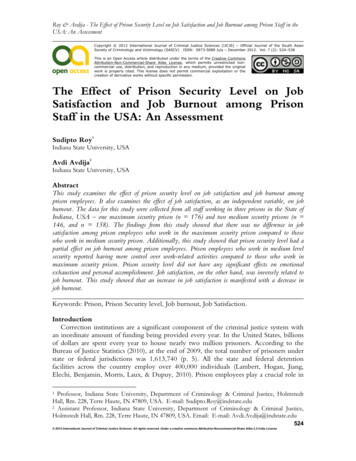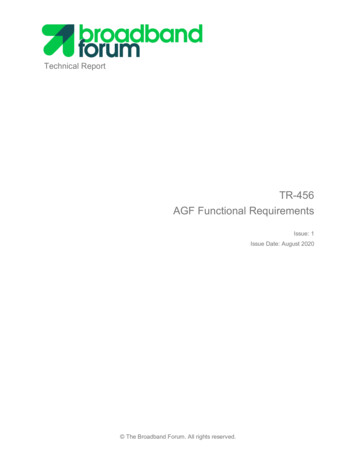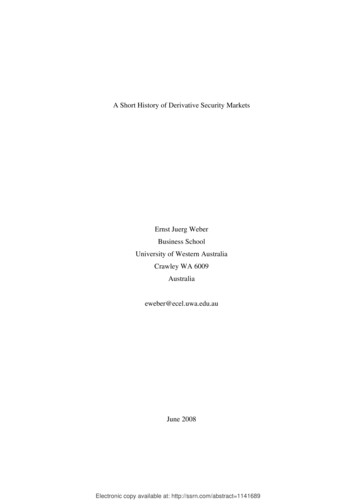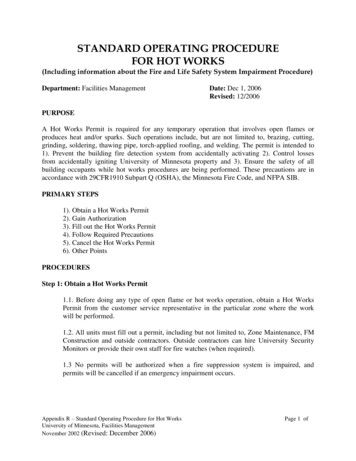
Transcription
Roy & Avdija - The Effect of Prison Security Level on Job Satisfaction and Job Burnout among Prison Staff in theUSA: An AssessmentCopyright 2012 International Journal of Criminal Justice Sciences (IJCJS) – Official Journal of the South AsianSociety of Criminology and Victimology (SASCV) ISSN: 0973-5089 July – December 2012. Vol. 7 (2): 524–538This is an Open Access article distributed under the terms of the Creative CommonsAttribution-Non-Commercial-Share Alike License, which permits unrestricted noncommercial use, distribution, and reproduction in any medium, provided the originalwork is properly cited. This license does not permit commercial exploitation or thecreation of derivative works without specific permission.HTUUTHTTTThe Effect of Prison Security Level on JobSatisfaction and Job Burnout among PrisonStaff in the USA: An AssessmentSudipto Roy1Indiana State University, USAAvdi Avdija2Indiana State University, USAAbstractThis study examines the effect of prison security level on job satisfaction and job burnout amongprison employees. It also examines the effect of job satisfaction, as an independent variable, on jobburnout. The data for this study were collected from all staff working in three prisons in the State ofIndiana, USA – one maximum security prison (n 176) and two medium security prisons (n 146, and n 158). The findings from this study showed that there was no difference in jobsatisfaction among prison employees who work in the maximum security prison compared to thosewho work in medium security prison. Additionally, this study showed that prison security level had apartial effect on job burnout among prison employees. Prison employees who work in medium levelsecurity reported having more control over work-related activities compared to those who work inmaximum security prison. Prison security level did not have any significant effects on emotionalexhaustion and personal accomplishment. Job satisfaction, on the other hand, was inversely related tojob burnout. This study showed that an increase in job satisfaction is manifested with a decrease injob burnout.Keywords: Prison, Prison Security level, Job burnout, Job Satisfaction.IntroductionCorrection institutions are a significant component of the criminal justice system withan inordinate amount of funding being provided every year. In the United States, billionsof dollars are spent every year to house nearly two million prisoners. According to theBureau of Justice Statistics (2010), at the end of 2009, the total number of prisoners understate or federal jurisdictions was 1,613,740 (p. 5). All the state and federal detentionfacilities across the country employ over 400,000 individuals (Lambert, Hogan, Jiang,Elechi, Benjamin, Morris, Laux, & Dupuy, 2010). Prison employees play a crucial role inProfessor, Indiana State University, Department of Criminology & Criminal Justice, HolmstedtHall, Rm. 228, Terre Haute, IN 47809, USA. E-mail: Sudipto.Roy@indstate.edu2 Assistant Professor, Indiana State University, Department of Criminology & Criminal Justice,Holmstedt Hall, Rm. 228, Terre Haute, IN 47809, USA. Email: E-mail: Avdi.Avdija@indstate.edu1524 2012 International Journal of Criminal Justice Sciences. All rights reserved. Under a creative commons Attribution-Noncommercial-Share Alike 2.5 India License
International Journal of Criminal Justice SciencesVol 7 Issue 2 July – December 2012the success or failure of prison facilities due to their responsibilities of running safe andsecure correctional institutions. As Lambert (2001) mentioned, it is a fact that prison staffhave a significant effect on how correctional institutions operate. At the same time, it isalso a fact that correctional institutions have a significant effect on their staff, in terms ofjob-related affective well-being, job satisfaction, and job burnout. Since the 1980s,researchers have focused on these issues among prison staff or prison employees.In general, the term prison staff includes several categories, namely administrative staff,custodial staff, treatment staff, health care staff, as well as staff involved in vocational,educational, and occupational activities. Some researchers have focused solely on custodialstaff (Castle, 2008; Keinan & Malach-Pines, 2007; Morgan, Van Haveren, & Pearson,2002), while others studied prison staff in general (Griffin, Hogan, Lambert, Tucker-Gail,& Baker, 2010; Garland & McCarty, 2009; Lambert & Paoline, 2005; Lambert, Hogan, &Allen, 2006; Schaufeli and Peeters, 2000; Lambert, Barton, and Hogan, 1999). All theprevious researchers have reported that prison environment affects emotional well-beingof the prison staff, brings about stress among them, affects their job satisfaction, andultimately culminates into job burnout among many prison staff. However, scant attentionhas been paid by researchers on how the level of prison security (e.g., maximum securityvs. medium/minimum security) impacts the prison staff in terms of job satisfaction and jobburnout. Hence, in this study, we attempt to investigate that issue. The findings of thisresearch study are based on the analysis of the data that we have collected from all theprison staff who worked in three medium and maximum security prisons in the State ofIndiana in January 2010. The total sample for this study consisted of 480 prison employees(322 males and 157 females).Review of Literature: Job Satisfaction and Job BurnoutJob satisfaction and work-related issues continue to be intriguing topics of research(Castle, 2008). A great number of researchers have studied job satisfaction as a predictingvariable of stress, job turnover, and job burnout (Garland & McCarty, 2009; Dowden &Tellier, 2004; Byrd, Cochran, Silverman, & Blount, 2000; Lambert, Barton, & Hogan,1999). Castle and Martin (2006), for instance, reported “job satisfaction as the strongestpredictor of job stress over any other variables” (p. 49). On the other hand, otherresearchers have examined job satisfaction as an outcome variable, and some of thepredictors of job satisfaction were role problems (Hepburn & Knepper, 1993; VanVoorhis, Cullen, Link, & Wolfe, 1991; Whitehead & Lindquist, 1986), being a part of thedecision-making process (Hepburn & Knepper, 1993; Whitehead and Lindquist, 1986),support from supervisors (Britton, 1997; Van Voorhis et al., 1991; Jurik & Winn, 1987),and notions on policies and the American Correctional Standards (Paoline, Lambert, &Hogan, 2006).Job SatisfactionHoppock (1935) was one of the first scholars to provide a systematic measurement ofjob satisfaction. Afterward, a large number of scholars have measured job satisfactioncovering a wide range of disciplines. By 1995, Spector, Jex, and Chen had estimated thatthe number of studies that were focused on job satisfaction in some fashion was overtwelve thousand (Lambert, Barton, & Hogan, 1999). Hence, it is evident that jobsatisfaction has been of prodigious interest to an inordinate number of researchers from a525 2012 International Journal of Criminal Justice Sciences. All rights reserved. Under a creative commons Attribution-Noncommercial-Share Alike 2.5 India License
Roy & Avdija - The Effect of Prison Security Level on Job Satisfaction and Job Burnout among Prison Staff in theUSA: An Assessmentwide range of disciplines, including corrections. Nonetheless, the issue is how thoseresearchers defined job satisfaction.Several scholars have attempted to define job satisfaction. For instance, Hopkins (1983)defined job satisfaction as “the fulfillment or gratification of certain needs that wereassociated with one’s work” (p. 7). In 2003, Spector defined job satisfaction, in plainwords, as “the extent to which people like their jobs” (p. 210). Job satisfaction has beendefined as a positive orientation of an individual toward the work role which he or she ispresently occupying (Griffin et al., 2010). A variety of factors can influence an individual’slevel of job satisfaction. Some of those factors include pay grade, the process of promotion,working conditions, leadership, social relationships, and the job itself. Job satisfaction isdefined as the pleasurable emotional state resulting from the appraisal of an individual’s jobas achieving or facilitating the individual’s values. Both satisfaction or dissatisfaction areseen as a function of perceived relationship between what an individual wants from his orher job and what that individual perceive it as offering or entailing. Thus, “job satisfactionis an attitude which reflects the degree to which an individual is satisfied , gratified, orfulfilled in his or her work or job” (Sharma, Verma, Verma, & Malhotra, 2010, p. 349).Overall, job satisfaction is a multidimensional construct.As for previous research on corrections, Lambert, Hogan, and Barton (2002) definedjob satisfaction as “a subjective individual level feeling reflecting whether a person’s needsare or are not being met by a particular job” (p. 116-117). A number of researchers whohave studied job satisfaction in correctional institutions maintain that low job satisfactionin prisons opens a gateway in reduction of both individual and organizational productivity.They also maintain that when job satisfaction diminishes, correctional staff tends to havemore work absences (Lambert, Edwards, Camp, & Saylor, 2005) and higher rates ofturnover (Dennis, 1998; Robinson, Porporino, & Simourd, 1997; Jurik & Winn, 1987).Previous researchers also contend that absenteeism and turnover resulting from low jobsatisfaction pose financial obstacles to prisons (Camp & Lambert, 2006; McShane,Williams, & McClain, 1991) and placed strain on prison staff who then have to fill-in thevacant roles (Camp & Lambert, 2006). Research shows that in situations where turnoverhas consistently been high, the overall morale of the prison staff tends to suffer (Lambert,2001).Apparently, there is a general consensus in the previous literature on corrections thatjob satisfaction is an effective response by a correctional staff concerning specific workduties in a correctional institution. This response culminates from an individual’s overallcomparison of the actual outcomes in what is expected, needed, wanted, desired, orperceived to be fair or just under normal conditions (Cranny, Smith, & Stone, 1992;Heffron, 1989). That is, job satisfaction is a subjective, individual level sensitiveness thatreflects whether a correctional staff’s needs are or are not being met by a specific job in thecorrection institution. Overall, the body of previous research on job satisfaction can bedivided into several categories. Among those categories are: personal, social, andorganizational satisfaction. These categories have been associated with size of the prisonorganization, individual demographics such as age, gender, marital status, and education(Jayaratne, Chess, & Kunkel, 1986; Jayaratne, Tripodi, & Chess, 1983; Glenn & Weaver,1982), and social support at work place (Jayaratne et al., 1986; Jayaratne et al., 1983). It isnoteworthy that a great amount of prior research on job satisfaction is similar to researchthat has been conducted on job burnout. That is to say, previous researchers maintain that526 2012 International Journal of Criminal Justice Sciences. All rights reserved. Under a creative commons Attribution-Noncommercial-Share Alike 2.5 India License
International Journal of Criminal Justice SciencesVol 7 Issue 2 July – December 2012job satisfaction and job burnout go hand in hand. Given that context, the followingsection delineates job burnout among prison staff.Job BurnoutFreudenberger (1974) defined job burnout as a situation when an employee becomespsychologically and physically exhausted due to work place situations. Freudenberger’sdefinition referred to a state of exhaustion which resulted from failure, fatigue, loss ofenergy, or unmet demands on an employee’s inner resources (Arabaci, 2010). In otherwords, burnout is a depletion of an employee’s physical and mental resources leading topersonal and professional difficulties. Maslach and Jackson in 1981 defined burnout as “asyndrome of emotional exhaustion and cynicism that occurs frequently among individualswho work with people” (p. 99). Cherniss (1980a, 1980b) also perceived burnout as theemotional and psychological exhaustion of an employee. Both Cherniss (1980a, 1980b)and Maslach and Jackson (1981) maintained that factors in the work place were the primalcauses for burnout among employees. In simple words, burnout is the emotional as wellas physical exhaustion experienced by an employee due to stressful work environment.Burnout is generally defined as the end result of a prolonged exposure to stressful workenvironment (Lindquist and Whitehead, 1986; Maslach & Jackson, 1984; Maslach, 1982;Cherniss, 1980a, 1980b).Although the explanations of burnout vary among researchers, Maslach (1982) hasmaintained that job burnout consists of three basic core dimensions, namelydepersonalization, reduced personal accomplishments, and emotional exhaustion.According to Maslach (1982), depersonalization first takes place as employees becomefrustrated with their jobs, become less concerned about their clients, and culminates inincreasingly negative work-related attitudes. The second stage of burnout is a reduction inpersonal accomplishment, which equates to a job-related sense of inadequacy and feelingsof failure (Maslach, 1982). Emotional exhaustion is the final stage of burnout and occurswhen employees feel overextended by their work (Maslach, 1982), resulting in decreasedjob productivity (Pearlman & Hartman, 1982).In the field of corrections, several studies have been conducted on job burnout amongcorrectional employees. In general, prior research shows that correctional employees sufferfrom burnout (see Lambert, Hogan, Jiang, et el., 2009; Keinan & Malach-Pines, 2007;Garland, 2004; Morgan, Van Haveren, & Pearson, 2002; Hurst & Hurst, 1997; Lindquist& Whitehead, 1986; for review). Some studies conducted in the United States provideapproximate percentages of burnout among prison staff. Hurst and Hurst’s (1997) study,for example, shows that about 64% of prison staff in Kentucky institutions, 33% of prisonstaff in Alabama, and 17% of educational instructors in Illinois prisons suffered from jobburnout (Hurst & Hurst, 1997, see also Garland, 2004).Research that has been focused on possible origins and consequences of stress leadingto burnout among prison staff has revealed several contributing factors. The mostfrequently reported predictors of burnout among prison staff are role ambiguity (Morganet al., 2002; Dignam, Barrera, & West, 1986; Shamir & Drory, 1982), role conflict(Whitehead & Lindquist 1986; Shamir & Drory, 1982), work load (Triplett, Mullings, &Scarborough, 1996; Long & Vogues, 1987; Dignam et al., 1986), understaffing (Rutter &Fielding, 1988; Lindquist & whitehead, 1986), lack of environmental control (Rutter &Fielding, 1988; Lombardo, 1981), lack of participation in decision-making process(Whitehead & Lindquist 1986; Lasky, Gordon, & Srebalus, 1986), inmate contact (Saylor527 2012 International Journal of Criminal Justice Sciences. All rights reserved. Under a creative commons Attribution-Noncommercial-Share Alike 2.5 India License
Roy & Avdija - The Effect of Prison Security Level on Job Satisfaction and Job Burnout among Prison Staff in theUSA: An Assessment& Wright, 1992; Whitehead & Lindquist 1986), and confrontations with inmates as anissues that concerns with job safety in the prison environment (Triplett et al., 1996; Grossi& Berg, 1991; Long & Vogues, 1987). In addition, several researchers have reported thatthe physical layout of prisons is a significant predictor of job burnout among correctionalemployees (O’Donnell & Stephens, 2001; Launay & Fielding, 1989; Harenstam & Palm,1988; Gerstein, Topp, & Correll, 1987; Dignam et al., 1986).Previous research on the impact of institutional conditions, such as shift work (i.e., dayshift, evening, and night shift) and prison security level, has revealed inconsistent findings.Van Voorhis, Cullen, Link, and Wolfe (1991) in their study reported that an officer’s shiftwas not a significant predictor of stress leading to job burnout. In contrast, Whitehead andLindquist (1986) found that officers who worked day shifts had greater level of stress,leading to burnout, compared to officers who worked evening and night shifts. Likewise,Hughes and Zamble (1993) reported shift work as a stressor that leads to job burnout.As can be seen in the literature above, scant attention has been paid by previousresearchers in evaluating the impact of prison security levels (e.g., maximum vs. mediumsecurity level) on job burnout among prison staff. In addition, the reported findings fromprior research on this issue are not consistent. For instance, Van Voorhis et al. (1991)reported that prison employees who worked in maximum security settings were moreinclined to experience greater level of job stress compared to the prison employees whoworked in medium and minimum security prisons, a variable that leads to job burnout. Incontrast, Morgan and his associates (2002) did not find support for the findings reportedby Van Voorhis et al. (1991). Another study conducted by Lasky et al. (1986) reportedthat the prison employees who worked in different prison security levels did not vary intheir reported burnout situations, although the staff in maximum security level did indicatea greater concern for their personal safety.Overall, the discussion presented above indicates that only a handful of previousresearchers have investigated job satisfaction and job burnout among the staff who work inmaximum and medium security prisons. Most of those studies have indirectly measuredthese differences. Even those studies that have measured the difference in job satisfactionand job burnout in terms of prison security level, have reported mixed and contradictingfindings, which warrant the need for further testing in this area.The Present StudyThe purpose of this study is to investigate if there is a significant difference in jobsatisfaction among correctional employees who work in the medium security prisonscompared to those who work in the maximum security prisons, using the security level asan independent variable. Second, we examine the effect of prison security level on jobburnout among correctional employees. Third, we examine the effect of job satisfactionon job burnout among correctional employees, while controlling for the effects of selecteddemographic characteristics (e.g., age, gender, marital status, and education) and the yearsof service in the correctional institutions. In this paper, the examination of theindependent effect of job satisfaction on job burnout is secondary in nature.MethodParticipantsThe data for this study were collected by using survey instruments from all employeeswho worked in the three different prisons in Indiana during January 2010. The total528 2012 International Journal of Criminal Justice Sciences. All rights reserved. Under a creative commons Attribution-Noncommercial-Share Alike 2.5 India License
International Journal of Criminal Justice SciencesVol 7 Issue 2 July – December 2012sample consisted of 480 (157 females and 322 males) prison employees from two mediumsecurity prisons (n1 158 or 32.9% and n2 146 or 30.4%) and one maximum securityprison (n3 176 or 36.7%). All three prisons were located in the State of Indiana. Theportion of male participants in the total sample was considerably higher than femaleparticipants (67.1% vs. 32.9%). The participants ranged in age from 18 to 68 (M 44.17,SD 11.47). The years of service in the correctional institutions for the participants in thetotal sample ranged from 1 to 38 (M 11.99, SD 8.14). In terms of the current workpositions they held in the correctional institutions at the time when they were surveyed,51.9% of them were correction
Attribution-Non-Commercial-Share Alike License UTH, Twhich permits unrestricted non-commercial use T, distribution, and reproduction in any medium, provided the original work is properly cited. TThis license does not permit commercial exploitation or the










